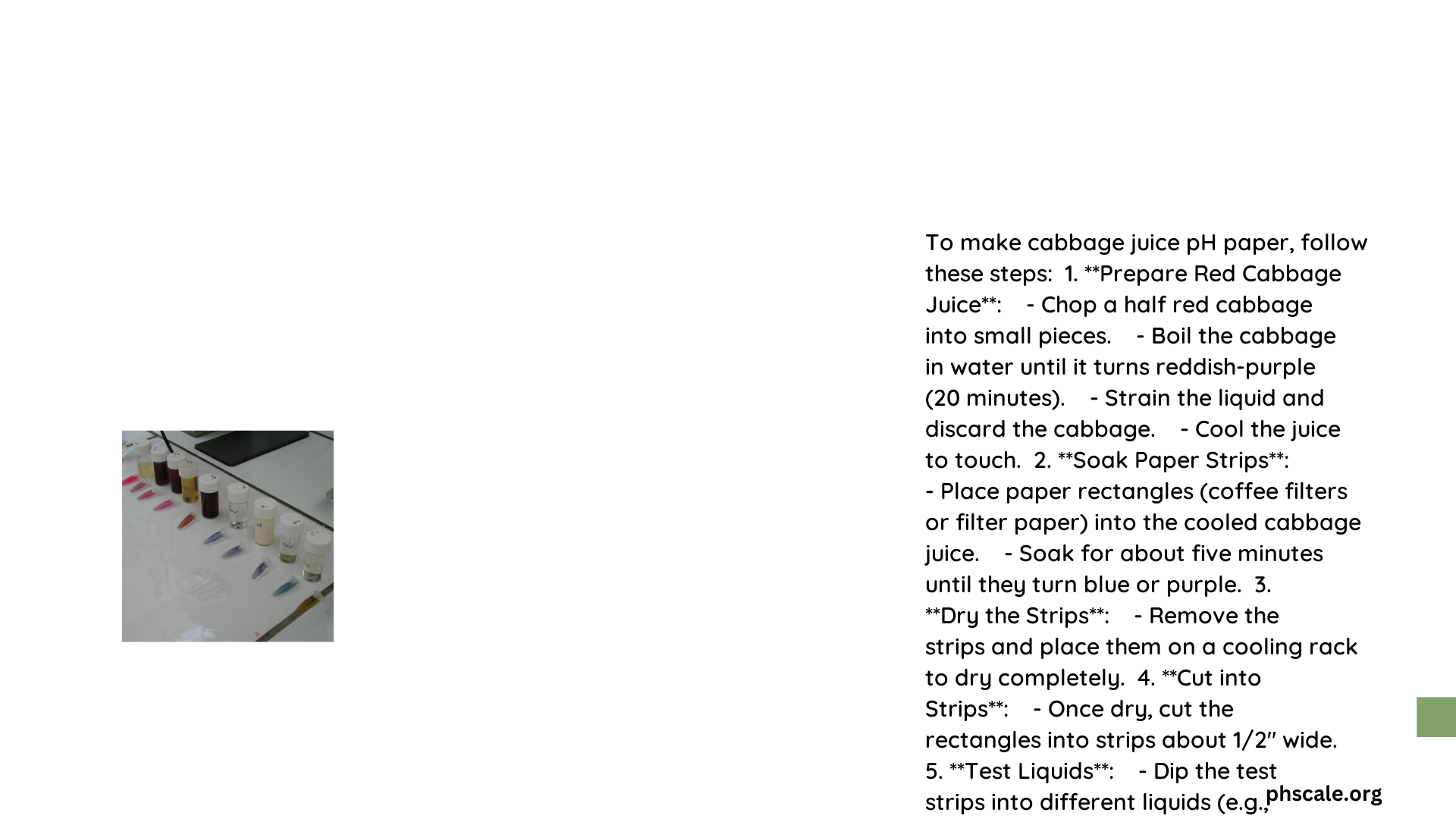Cabbage juice pH paper is a simple yet powerful tool for measuring acidity and alkalinity. This natural indicator, derived from red cabbage, changes color across a wide pH spectrum, making it an excellent alternative to commercial pH strips. Easy to make at home, cabbage juice pH paper offers a cost-effective and educational way to explore pH levels in various substances. Its vibrant color changes provide clear visual cues, making it ideal for both scientific experiments and everyday household use.
What is Cabbage Juice pH Paper?
Cabbage juice pH paper is a natural pH indicator made from red cabbage extract. It changes color in response to different pH levels, allowing users to determine the acidity or alkalinity of various substances. This eco-friendly alternative to synthetic pH indicators is popular in educational settings and home experiments due to its accessibility and vivid color changes.
How Does Cabbage Juice pH Paper Work?

Cabbage juice pH paper works due to the presence of anthocyanins, water-soluble pigments found in red cabbage. These compounds change their molecular structure in response to different pH levels, resulting in distinct color changes. The paper absorbs the cabbage juice, which then reacts with the substance being tested, producing a color that corresponds to a specific pH range.
What are the Benefits of Using Cabbage Juice pH Paper?
- Natural and Non-Toxic: Made from food-grade ingredients, safe for handling.
- Cost-Effective: Can be made at home with readily available materials.
- Wide pH Range: Covers pH 1-12, suitable for most common substances.
- Educational Value: Demonstrates pH concepts visually, great for science projects.
- Eco-Friendly: Biodegradable and chemical-free alternative to synthetic indicators.
How to Make Cabbage Juice pH Paper?
Materials Needed:
- Red cabbage (1 head)
- Boiling water
- Strainer or cheesecloth
- Coffee filters or thick paper towels
- Baking sheet
- Oven
Steps:
- Chop the red cabbage and boil in water for 10-15 minutes.
- Strain the liquid and let it cool.
- Soak coffee filters or paper towels in the cooled cabbage juice.
- Lay the soaked papers on a baking sheet.
- Dry in an oven at the lowest setting or air dry for 24 hours.
- Cut the dried paper into strips.
What are the Color Changes for Different pH Levels?
| pH Range | Color |
|---|---|
| 1-3 (Highly Acidic) | Red to Pink |
| 4-5 (Acidic) | Pink to Lavender |
| 6-7 (Neutral) | Violet to Blue |
| 8-9 (Basic) | Blue-Green |
| 10-12 (Highly Basic) | Green to Yellow |
How Accurate is Cabbage Juice pH Paper?
Cabbage juice pH paper provides a good approximation of pH levels, typically accurate within 1-2 pH units. While not as precise as electronic pH meters, it’s sufficient for most educational and home applications. For more accurate results, compare the color changes to a standardized chart created using solutions of known pH.
What are Some Common Applications of Cabbage Juice pH Paper?
- Educational Experiments: Demonstrating acid-base reactions in science classes.
- Gardening: Testing soil pH to determine plant suitability.
- Cooking: Checking the acidity of preserves or fermented foods.
- Pool Maintenance: Monitoring pool water pH levels.
- Aquarium Care: Ensuring proper water conditions for fish.
How to Store Cabbage Juice pH Paper?
To maintain the effectiveness of cabbage juice pH paper:
- Store in an airtight container
- Keep away from direct sunlight
- Store in a cool, dry place
- Avoid exposure to strong acids or bases
- Use within 3-6 months for best results
What are the Limitations of Cabbage Juice pH Paper?
- Limited Precision: Not suitable for applications requiring exact pH measurements.
- Color Interpretation: Subjective color perception may affect readings.
- Shelf Life: Shorter lifespan compared to commercial pH strips.
- Interference: Some colored or opaque solutions may mask the indicator color.
- Temperature Sensitivity: Extreme temperatures can affect color accuracy.
How Does Cabbage Juice pH Paper Compare to Commercial pH Strips?
| Aspect | Cabbage Juice pH Paper | Commercial pH Strips |
|---|---|---|
| Cost | Low | Moderate to High |
| Accuracy | Moderate | High |
| pH Range | Wide (1-12) | Varies (some cover full range) |
| Ease of Use | Easy | Easy |
| Shelf Life | 3-6 months | 1-3 years |
| Environmental Impact | Low | Moderate |
What Safety Precautions Should be Taken When Using Cabbage Juice pH Paper?
While cabbage juice pH paper is generally safe, follow these precautions:
- Avoid ingesting the paper or tested substances.
- Wear gloves when handling unknown or potentially harmful substances.
- Work in a well-ventilated area, especially when testing strong acids or bases.
- Keep materials away from eyes and mouth.
- Supervise children during experiments.
By understanding the properties, applications, and limitations of cabbage juice pH paper, you can effectively utilize this natural and engaging tool for pH testing in various settings. Whether for educational purposes or practical household use, cabbage juice pH paper offers a colorful and accessible way to explore the world of acids and bases.
References:
1. Red Cabbage Indicator – Flinn Scientific
2. Science At Play: Red Cabbage Juice Indicator – Connecticut Science Center
3. Cabbage pH Indicator – Canada Science and Technology Museum
